Using a Metal Hook to Pick a Baby's Nose
Abstract
Background: Nasal foreign trunk (NFB) is a common presentation to the emergency department (ED). It is oftentimes a dilemma for the treating physician to choose the best method as removal of NFB can be challenging, frustrating and lamentable for the dr., the patient, and the patient's parents.
Method: We take listed the 20 possible methods one could use to remove NFB in an ED setting.
Results
- Positive Pressure (Child) Method
- Positive Pressure (Parent) Method – Too known as the kissing technique
- Modified Positive Pressure (Parent) Method – It is a modification to the kissing technique
- Positive Pressure with Ambu bag
- Positive-Pressure Device
- Beamsley Equalizer Positive-Pressure Device
- Saline Washout Technique
- Cyanoacrylate (super gum)
- Catheters
- The Katz extractor
- Using a Magnetic Device
- Instrumentation – Alligator/Crocodile forceps
- Instrumentation – Tilley nasal packing forceps
- Instrumentation – Jobson-Horne Probe / ring curette / wax loop
- Instrumentation – Correct angle probe
- Instrumentation – Frazier suction catheter
- Instrumentation – Cut-down flexible suction catheter
- Instrumentation– Refashioned / bent newspaper clips
- Snare Technique - Wire loop snare grasped by hemostat
- ''Hook-Scope'' Technique for Endoscopic Extraction of NFB
Word: Any of the called methods has its ain benefits and almost are suitable for some but non all NFB shapes. In addition, for the removal of NFB with whatsoever technique to be successful, four prerequisite needs to be fulfilled which are: a well restrained patient, a proficient head light with optimal illumination, a nasal speculum and decongested nasal cavity.
Conclusion: The child normally allows only one or two attempts at most for removal of NFB, hence appraise the child carefully and if you lot do non feel yous are the right person for the job, get help from seniors or direct referral to the ENT team should you anticipate a difficult removal of a NFB.
Cardinal words
strange body, emergency department, nasal, removal
Objective
Nasal foreign torso (NFB) is a not an uncommon presentation to the emergency section (ED) and makes up approximately 0.1% of paediatric emergency department visits [1]. Virtually usually found NFB are object of interest to children such as beads, toys, jewels, sweets, stones, batteries and fifty-fifty magnets. For the dilemma facing the treating physician is to choose the best method of removing the NFB. Removal of NFBs tin be challenging, frustrating and sad for the physician, the patient, and the patient'due south parents. In this commodity, we report twenty means of removing NFBs in the emergency section.
Methods
A literature search was performed to look for additional means of removing NFB other than those nosotros routinely apply. Thus by examining published methods, coupled with our experiences, we take compiled a list of all the possible methods 1 could employ in removing NFB in an ED setting.
Results
Positive Pressure (Child) Method [1]
Technique: Child to exhale forcibly through the nostril containing the object with the opposite nostril occluded and the oral cavity closed.
Skillful for:Solid object e.g. beads
Note: Difficult or impossible for young patients to accomplish on their own.
Modified Positive Pressure (Parent) Method – a modification of the kissing technique
Technique: Using drinking harbinger, or similar tubing, betwixt the parent'southward mouth and kid's mouth, the kid is instructed to make a tight seal, as if drinking, and the parent delivers a quick puff [1,3].
Good for: Solid object e.k. beads
Annotation: Risk of bleeding from tip of straw or rigid tubing if patient moves.
Positive Pressure with Ambu bag
Technique: Oral insufflation with an ordinary Ambu bag [one].
Good for: Solid object eastward.g. beads
Note: Reasonable alternative in instances when parent and child have difficulty cooperating with the parent-applied oral fissure-to-mouth positive pressure level.
Positive-Pressure Device [4]
Technique: Nasal occlusion device consisting of a medium or large disposable headset attached to an 8F feeding tube (Figure 1). The headset includes a hose that is continued to a standard oxygen outlet, with an oxygen flow rate of 15 L/min which is equivalent to an output pressure of 100 to 160 mm Hg. With the patient restrained and properly positioned (sitting on parent'due south lap), the apoplexy device is connected to the oxygen hose. The oxygen outlet is opened with a pressure level of 15 L/min, and the hose bent to occlude passage of pressure. Later the device was placed in the unaffected nostril, the pressure was suddenly released and the device was immediately removed.
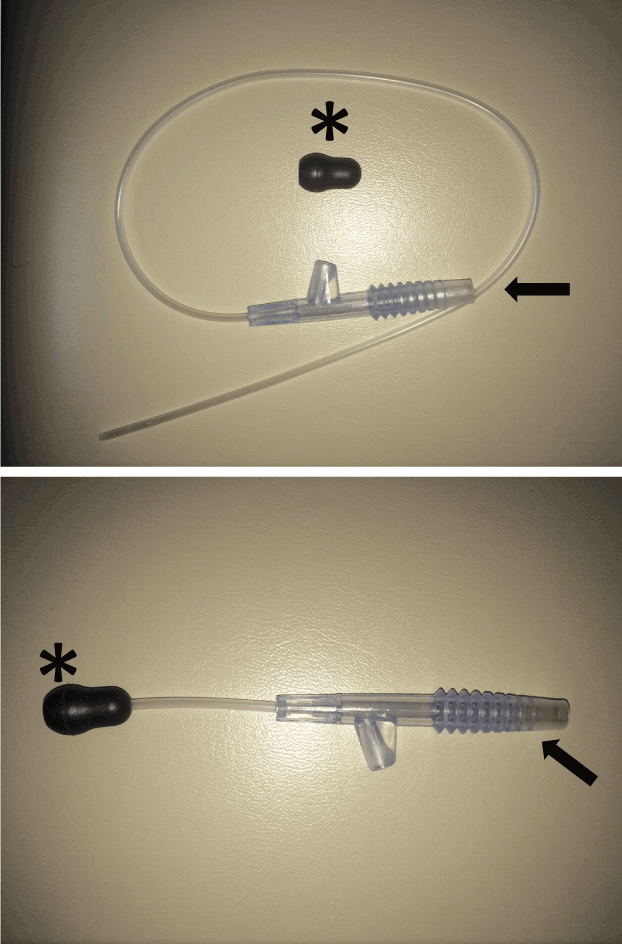
Figure 1. An 8F feeding tube (arrow); dispensable headset (asterisk) 4.
Expert for: Solid object e.g. beads
Note: This device is comfortable, easy to use, and regulates sufficient positive force per unit area necessary to expel a NFB.
Beamsley Blaster Positive-Force per unit area Device [iv]
Technique: Uses an oxygen tube adapter that provides unmodulated force per unit area in the posterior nasopharynx to eject the NFB.
Good for: Solid object e.thousand. beads
Notation: Barotrauma manifested as periorbital subcutaneous emphysema has been reported every bit a complication and is therefore a take a chance.
Saline Washout Technique [1,5]
Technique: A bulb syringe filled with approximately 7 ml of sterile normal saline is placed in the opposite nostril. The bulb syringe is avant-garde several centimetres into the nasal crenel and so that a tight seal is maintained. The bulb syringe is forcibly squeezed and the object is propelled out by the menses of saline back through the nasal passage that contains the foreign torso.
Skillful for: Friable foreign body
Notation: Potential reflux of saline and/or nasal contents into the eustachian tubes and potential aspiration of the foreign body [5]. However, no known agin event has been reported past investigators who accept regularly performed this technique to obtain nasal specimens for research studies [5].
Cyanoacrylate (super mucilage)
Technique: Cyanoacrylate applied to the cease of a plastic swab stick for the removal of nasal strange bodies 1. The stick must be pressed and held onto the NFB for 60 seconds earlier being withdrawn.
Good for: Solid object e.chiliad. beads
Annotation: Any cyanoacrylate stuck and remaining on the pare can be removed using 3% hydrogen peroxide or acetone.
Catheters
Technique: Any catheters such as Foley catheters, Fogarty vascular catheters, or Fogarty biliary balloons can be used [ane,half-dozen]. After checking the integrity of the balloon, the catheter is inserted above and distal to the foreign object (passing the catheter below the object can potentially bulldoze the object into a tighter position). Once across the foreign torso, the balloon is inflated with a predetermined amount of saline (i mL for a no. 4 Fogarty catheter, two-iii mL for a no. 6 Fogarty or 8F Foley catheter) and maintained at that size with pressure from the practitioner'south thumb. Gentle traction is and then applied to remove the object [1] (Figure 2).
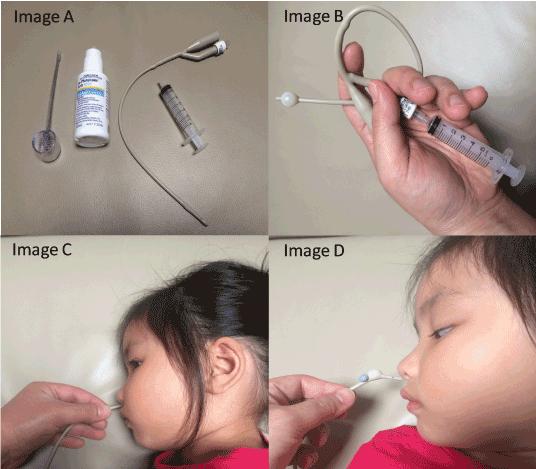
Figure 2. (Image A)Equipment required. (Image B) Determining required balloon size specific to each kid. (Image C)Balloon inflated one time predetermined insertion length achieved. (Image D) Gentle, steady traction allows FB removal 6.
Good for: Good for NFB that cannot be visualised, but has a reliable history or signs of NFB lodgement (unilateral nasal obstacle or discharge) [half dozen].
Note: Dwyer has reported more than 200 successful NFB removals in children via this technique which has become his sole strategy in removing NFB [half dozen].
The Katz extractor [1]
Technique: The success of the catheter method has led to the development of a disposable catheter made specifically for the removal of NFB chosen the Katz extractor [1]. The Katz extractor catheter is smaller than the catheters mentioned above, which results in a greater chance of the catheter being passed beyond the foreign trunk Due south
Good for: Skilful for NFB that cannot exist visualised
Notation: Like shooting fish in a barrel to use. It merely takes three elementary steps to complete an extraction with the Katz Extractor: - Insert / Inflate / Extract.
Using a Magnetic Device [vii]
Techniques: A strong magnet is used; for example in the ED setting it could exist the magnet used for deactivating pacemakers.
Skillful for: Metallic NFB and push batteries
Notes: If the NFB is a button bombardment this is a medical emergency; and must be removed every bit soon as possible.
Instrumentation – Alligator/Crocodile forceps [8] (Figure four)
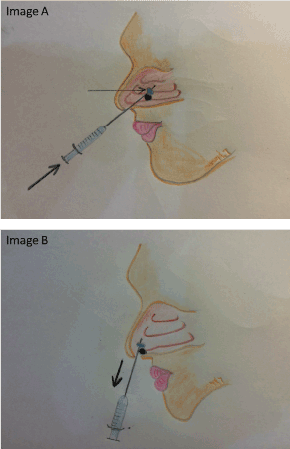
Figure three. (Image A) Katz extractor balloon inflated with air from connected syringe. (Paradigm B) Katz extractor removed with nasal foreign body 1.
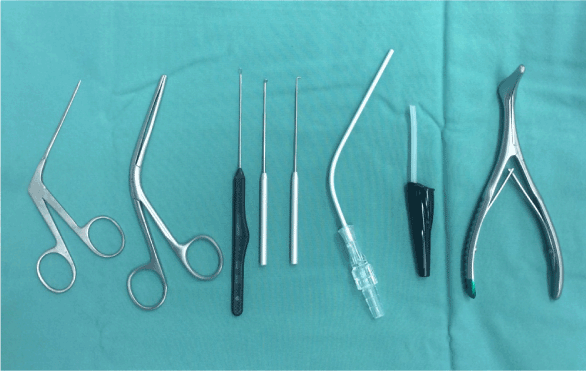
Figure 4. From left to correct: Alligator/Crocodile forceps, Tilley nasal packing forceps, wax loop, ring curette, right bending probe, Frazier suction catheter, cut-down flexible suction catheter and Killian nasal speculum.
Technique: Using i hand to elevate the nasal tip of the patient, the other hand inserts forceps into the nasal crenel to grasp the NFB
Good for: Any firm to hard NFB
Note: Not suitable for round NFB as repeated attempts to grasp but for object to escape could propel the NFB further back into the nasal cavity.
Instrumentation – Tilley nasal packing forceps [eight] (Figure four)
Technique: For removal of NFB deemed too big to exist grasp with Alligator forceps
Good for: Any business firm to difficult NFB
Notation: Non suitable for round NFBs as forceps are likely to skid off and propel the NFB back further into the nasal crenel.
Instrumentation – Jobson-Horne Probe/ring curette/wax loop [8] (Figure 4)
Technique: With nasal tip of the patient elevated using the other manus, the probe is inserted into the nasal cavity across the NFB, and then angle the tip is angled to allow the probe to propel the NFB out ahead of information technology as the probe is withdrawn from the nose 8.
Proficient for: Solid round object e.g. chaplet
Notation: This writer has found this method to have a 100% success rate and take consequently adopted this method every bit my practice of choice in removing NFB.
Instrumentation – Right angle probe [nine] (Figure iv)
Technique: the probe is manoeuvred alongside and past the NFB, then rotated information technology so that the right-angle is behind the NFB, then withdrawn along with the object [nine].
Proficient for: Solid object eastward.g. stones, Lego® pieces
Note: Gamble of epistaxis if patient moves or struggles while probe is in the nose
Instrumentation – Frazier suction catheter [9] (Figure 4)
Technique: Place the e2021 Copyright OAT. All rights reservface of the object, apply suction and gently pull out the catheter with the NFB attached.
Skilful for: Solid round object e.chiliad. beads
Note: Risk of epistaxis if patient moves or struggles while catheter is in the nose.
Instrumentation – Cut-down flexible suction catheter [9] (Figure four)
Technique: Place the cease of the suction catheter on the surface of the object, utilize suction and gently pull out the catheter with the NFB fastened.
Adept for: Solid round object due east.thousand. beads
Annotation: Less risk of epistaxis compared to using a Frazier suction catheter
Instrumentation– Refashioned / bent newspaper clips (Figure 5)
Technique: Works like a Jobson-Horne Probe / ring curette / wax loop.
Good for: Solid objects e.g. chaplet
Annotation: Use information technology when Jobson-Horne Probe / ring curette / wax loop is needed but cannot be establish.
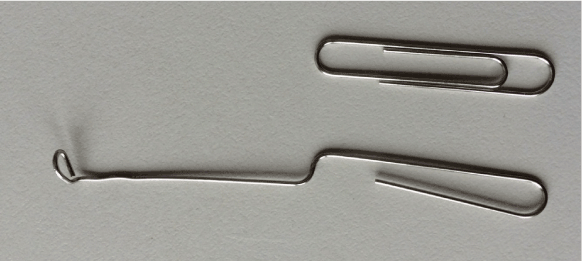
Figure v. Refashioned / bent newspaper clips
Snare Technique - Wire loop snare grasped by haemostat
Technique: A 24-estimate wire ''snare'' loop is created, then held and its position guided past a haemostat. The snare is inserted into the nasal aperture, and used to split up a plane between the NFB and the septal, turbinate and nasal floor mucosa until all sides were free. In one case the posterior free edge of the NFB is palpable with the loop, it is rotated ninety degrees and retracted outward, freeing the NFB and bringing it forward (Figure half dozen).
Expert for: Impacted NFB e.g.: push button battery
Notation: This technique is noted to be a rapid, atraumatic, and effective means for the removal of difficult NFBs [10].
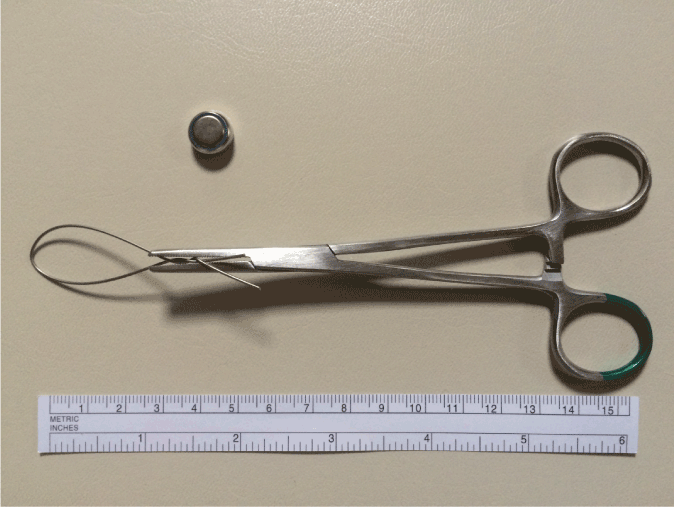
Effigy 6. Example of wire loop snare grasped past haemostat after successful atraumatic removal of nasal foreign body (bombardment) 10.
''Hook-Telescopic'' Technique for Endoscopic Extraction of NFB
Technique: A flexible nasal endoscope (iii.vii mm diameter) continued to a video system is needed. First assess the NFB and surrounding nasal cavity using the nasal endoscopy. Upon location of NFB, the scope'due south head is so turned superiorly to identify the nasal area to a higher place the superior margin of the NFB, which will be the pathway for the scope to travel through. The existence of such a pathway is a prerequisite for the success of this technique. The endoscope is afterwards avant-garde above and posterior to the NFB, and, finally descends to the area facing the nasal flooring in a manoeuvre that bypasses the object (Effigy vii). Subsequently a quick assessment of the posterior extension of the NFB and the status of the posterior nasal cavity, turned anteriorly towards the object, encasing the NFB like a hook. The NFB is so disengaged and mobilized, past gently pulling the scope anteriorly outward towards the nasal vestibule, keeping the NFB locked in the flexed mode and the object enclosed within its hook. Following successful extraction, a diagnostic nasal endoscopy is performed to reassess the entire nasal cavity.
The core of this technique is that the NFB is actually embraced by the endoscope, which subsequently acts as an extractor [11].
Good for: Posteriorly located and round objects that are difficult to grasp [xi].
Note: Particular attending must be paid in club not to inadvertently dislocate the object towards the choana. The endoscope may become damaged in the hands of unfamiliar operator.
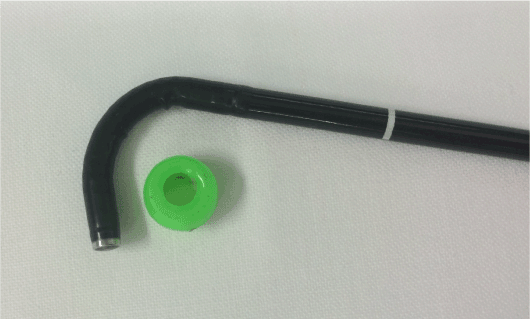
Effigy seven. Two-dimensional reproduction of the hook-scope manoeuvre 11.
Discussion
Any of the chosen method, from a non-instrumental method such as the positive force per unit area to instrumental extraction, has its ain benefits and advantages. For any removal of NFB to be successful, at that place are four prerequisite that needs to be fulfilled; these are: Outset – a restrained patient. A moving or mobile patient is at risk of epistaxis with instrumentation which volition brand the procedure of removing the NFB even more difficult, visualisation of the NFB almost impossible and risk posterior dislodgement of the NFB. A child can be safely and securely restrained by having the child sit on their parent'due south lap with the body facing to the front. The parent has one arm over the child's body and arms, and the parent's other arm holds onto the child's forehead, pushing the back of the kid' head against the parent's chest. The kid's lower limbs are securely locked between the parent's thighs (Figure eight).
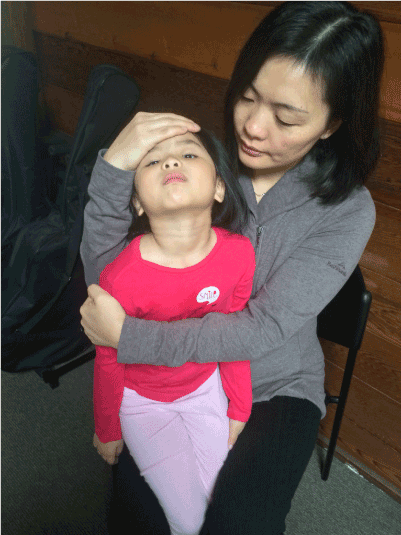
Figure 8. The correct method to restrain a child.
2d – a good head light, eg Vorotek headlight. I cannot over stress the importance of having a good otolaryngology headlight equally it frees both the operator's hands and gives a focus illumination into the tiny nasal cavities of the kid.
Third – a nasal speculum, e.yard. Killian nasal speculum (Figure four). In my early years every bit a junior registrar I missed NFB in 2 paediatric patients when examining without nasal speculum. Fortunately, both patients presented back for review and had proper nasal examination with nasal speculum where the NFB was identified and removed safely. Fourth - nasal decongestion and analgesia with local topical agent (cophenylcaine nasal spray). This is of import as it decongests and numbs the nasal cavity to assist in the removal of NFB. The topical spray is dose dependent, hence be careful when using it on paediatric patients.
Conclusions
It is downwards to the operator to find the method he or she is most comfortable with to remove NFBs. Acquit in heed, the child usually allows merely ane or two attempts at most for removal of NFB, hence assess the child carefully and if y'all do not feel like yous are the correct person for the job, go assist from seniors or straight referral to the ENT team if the removal of NFB is anticipated to be hard. If all else fails, no farther endeavor in removing the NFB in ED should be made, and NFB removal nether full general anaesthesia would be the next course of action.
Acknowledgments
I would like to thank Dr. Vicky Tobin, Ms. Ebony Dejager and Frankston Hospital Library
Financial support
This project was not financially supported from any external sources and was fully funded past the Department of Surgery, Frankston Hospital.
Conflict of involvement
The authors declare no conflict of interest
References
- Kiger JR, Brenkert TE, Losek JD (2008) Nasal foreign body removal in children. Pediatric Emergency Care 24: 785-792. [Crossref]
- Colleen T, Acheson J, Coats TJ (2010) Nasal foreign bodies in children: kissing it better. Emergency Medicine Periodical 27: 712-713. [Crossref]
- Benjamin E, Harcourt J (2007) The modified 'Parent'southward Kiss' for the removal of paediatric nasal foreign bodies. Clinical Otolaryngology 32: 120-121. [Crossref]
- de la O-Cavazos M, Ríos-Solís J, Montes-Tapia F, Elizondo-Omaña R, Cantu-Moreno D, (2014) Pediatric Emergency Care xxx: 94-96. [Crossref]
- Lichenstein R, Giudice EL (2000) Nasal wash technique for nasal foreign body removal. Pediatric Emergency Care 16: 59-threescore. [Crossref]
- Dwyer D (2015) Foley catheter technique for nasal foreign body removal in children. Emergency Medicine Australasia 27: 495-496.
- Alletag MJ, Jacobson D, Santucci K, Riera A (2014) Nasal disc battery removal - a novel technique using a magnetic device. Pediatric Emergency Care 30: 488-490. [Crossref]
- Motbey J (2001) How to remove foreign trunk from a kid's nose. Medicine Today two: 106-107.
- Craig SS, Cheek JA, Seith RW, Due west A (2015) Removal of ENT foreign bodies in children. Emergency Medicine Australasia 27: 145-147.
- Fundakowski CE, Moon S, Torres 50 (2013) The snare technique: a novel atraumatic method for the removal of difficult nasal foreign bodies. Journal of Emergency Medicine 44: 104-106. [Crossref]
- Giourgos M, Matti E, Colombo A, Pagella F (2009) "Claw-scope" technique for endoscopic extraction of nasal strange bodies. Laryngoscope 119: 1203-1205. [Crossref]
Editorial Information
Editor-in-Chief
Chin-Lung Kuo
Director of the Section of Otolaryngology
Hsinchu Armed Forces Hospital, Hsinchu
Taiwan
Article Blazon
Commentary
Publication history
Received engagement: Apr 05, 2016
Accepted date: April 22, 2016
Published date: April 26, 2016
Copyright
©2016 Tian-Tee Ng. This is an open-admission article distributed nether the terms of the Artistic Commons Attribution License, which permits unrestricted utilise, distribution, and reproduction in any medium, provided the original author and source are credited.
Citation
Tian-Tee Ng (2016) 20 ways of removing a nasal foreign torso in the emergency section. Otorhinolaryngol Head Neck Sur,1: doi: 10.15761/OHNS.1000102

Figure 1. An 8F feeding tube (arrow); disposable headset (asterisk) 4.

Figure 2. (Image A)Equipment required. (Prototype B) Determining required balloon size specific to each child. (Image C)Airship inflated once predetermined insertion length achieved. (Epitome D) Gentle, steady traction allows FB removal 6.

Figure three. (Image A) Katz extractor balloon inflated with air from connected syringe. (Image B) Katz extractor removed with nasal strange body 1.

Figure 4. From left to right: Alligator/Crocodile forceps, Tilley nasal packing forceps, wax loop, ring curette, right angle probe, Frazier suction catheter, cut-downwardly flexible suction catheter and Killian nasal speculum.

Effigy 5. Refashioned / bent paper clips

Effigy 6. Example of wire loop snare grasped by haemostat after successful atraumatic removal of nasal foreign body (bombardment) 10.

Figure 7. Two-dimensional reproduction of the hook-scope manoeuvre 11.

Figure 8. The correct method to restrain a child.
Source: https://www.oatext.com/20-ways-of-removing-a-nasal-foreign-body-in-the-emergency-department.php
0 Response to "Using a Metal Hook to Pick a Baby's Nose"
Post a Comment